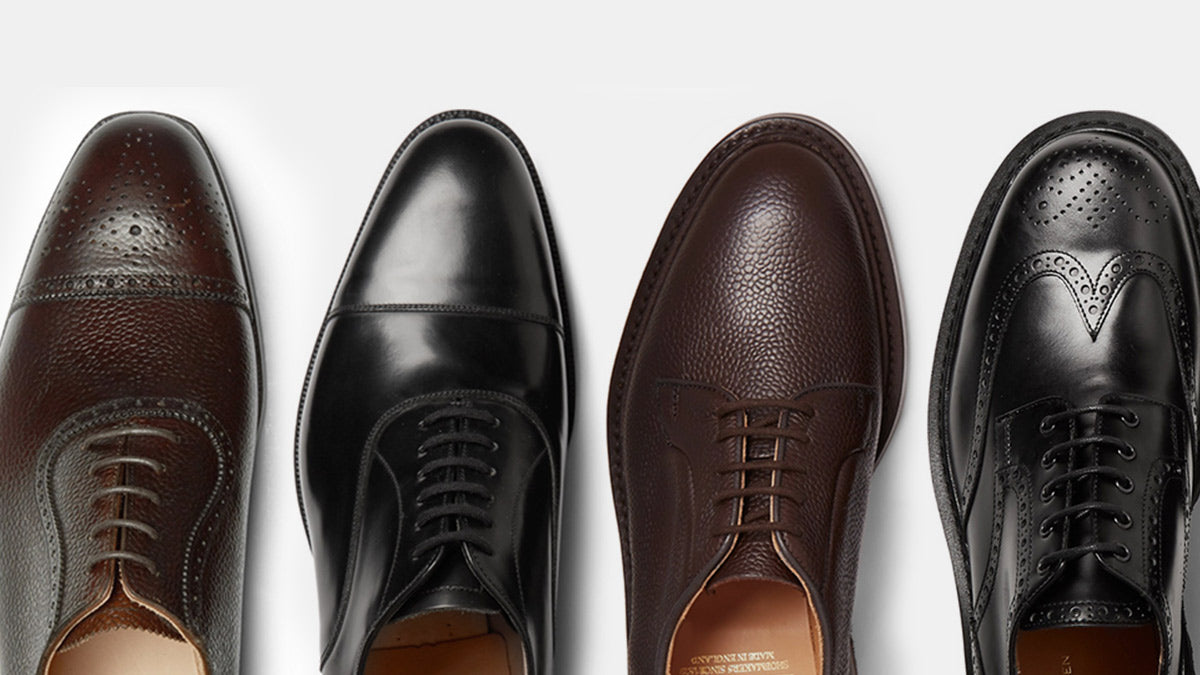
- Mar 19, 2018
- 0 comments
- by DAVIT GRIGORYAN
STYLES

Formal lace-up shoes can be split into two sorts: Derbies and Oxfords. Both include a vamp – the front of the shoe attached to the quarters (the upper section that covers the sides and back), a low heel and often a Goodyear welt construction. With Oxfords, the “facing” (where the eyelets are located) is sewn under the vamp. A closed lace gives a sleeker appearance, so a decent pair of black plain-toe Oxfords is your go-to dress shoe (buy them in patent leather for extra sophistication). Go with a cap toe and you’ll be at home in any boardroom.
Originating in Scotland, Oxfords are sometimes called “Balmorals” after Balmoral Castle.
2. Derby
Derbies have open laces (the facing is open at the bottom), giving a more robust and versatile feel – the trusty Land Rover to the elegant Audi A8 Oxford. They come in colors ranging from cognac and oxblood to other reds and browns and can be teamed with a suit, jeans or chinos. If you’re a little more traditional, adhere to their rustic roots and stick to trousers and a sports jacket. Sometimes called bluchers (especially in the US by New England preppies who grew up wearing a particular LL Bean model), there are subtle differences between the two, but this is best explained over a pint.

3. Brogue
If we were really picking holes – literally in this case – we would say that "brogue" refers to a detail: the perforations designed to drain water from the feet of our Gaelic ancestors. However, whether in an Oxford or Derby style – a brogue is very much a shoe in its own right. Wingtips are a brogue with a decorative detail on an extended toecap. Cap's toes are brogues with a plain toe, although often with perforations along the edge of the cap. Try box calf leather, suede or Scotch grain, depending on how relaxed you want to go.
4. Monk Strap
With its bold buckle, this shoe sits comfortably between an Oxford and a Derby in terms of formality, and as a rakish alternative to a lace-up. Single monk straps are more understated and timeless (try chocolate brown suede), while the two straps of a double monk exude a military feel – and are usually designed with a toecap. Although the style dates back many centuries when monks were looking for an alternative to the sandal, these shoes are favored by style aficionados looking for something different. They have been popularised in recent years.
5. Loafer
Despite the name, there’s nothing slovenly about slip-ons, yet they certainly offer a more laid-back look. The origin is disputed, but King George VI is said to have wanted an indoor shoe for his country house back in 1926. Low sitting and without laces, they have a moccasin-like upper, often with a piece of leather straddling the upper (the saddle). Note: no detail on the upper, and the presence of a heel, differentiates the loafer from its cousin, the moccasin. They are commonly Blake stitched but you can get Goodyear-welted pairs should you want to wear them as often as Mr Michael Jackson did. Classic styles include the penny, tassel and Gucci loafer.

6. Chukka
Ankle-high, constructed from two bits of leather and with two or three high-lacing eyelets, the chukka is related to the jodhpur boot in polo (a chukka is a period of seven-and-a-half minutes, trivia fans). The Chuka is a more casual shoe traditionally made from calfskin leather, but suede or black kid leather is dressier options. Crepe soles on desert boots were introduced by Mr Nathan Clark after he saw what soldiers were wearing on their feet during a trip to Burma in 1941. We prefer ours in brown or tan, and we’d advise not combining a crepe-soled chukka with a suit.
7. Chelsea boot
With quaint, equestrian origins dating back to Queen Victoria, Chelsea Boot – popularised by The Beatles and other British Invasion bands in the 1960s – is a bona fide rock’n’roll addition to any contemporary shoe collection. Comfortable and sleek, they are characterized by an elasticated gusset on the side (although many styles employ a zip – think Mr. Sammy Davis Jr or Austin Powers).


